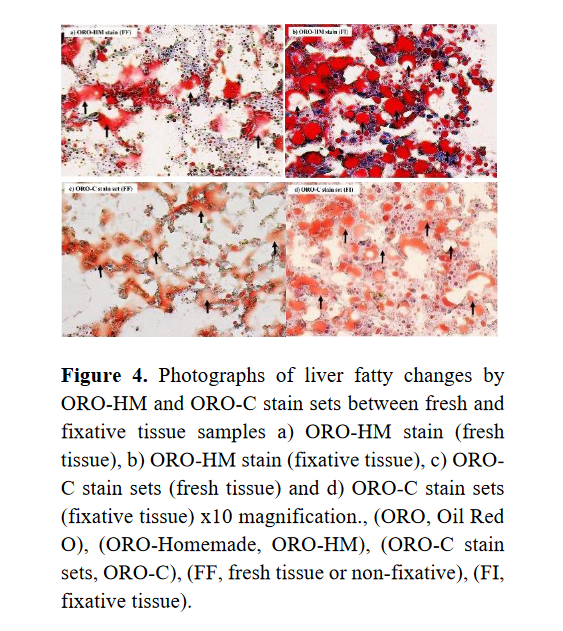Comparison of the Effectiveness of Two Histochemical Staining Techniques for Steatosis Detection in Liver Tissue and Application in Forensic Autopsy: A Case Study
DOI:
https://doi.org/10.53848/ssstj.v10i2.474Keywords:
Fatty change, Oil Red O, Fat embolis, Histochemical staining, Forensic medicineAbstract
Oil Red O (ORO) stain is lipophilic for stain fat and lipid components, it is one of the chemical reagents which have the potential to be utilized for forensic medicine to identify asphyxia deaths from pulmonary emboli, that are frequently occurred following an accident or sudden death. Consequently, it can increase forensic pathologists' confidence and lower the cost of delivering ORO stains to other units. Therefore, the authors were interested in comparing the effectiveness of commercial ORO-C and homemade ORO-HM in steatosis samples. Tissue samples were collected and divided into two groups namely with fixative and without any preservative.
Assessment of the persistence efficiency of ORO-HM at different storage periods was performed by four experts with a blind testing method. The results were compared by assessing the efficiency of two histochemical stains using the SPSS software. The results showed that ORO-HM in both fresh and formalin-fixed tissues represented decent efficiency in fatty changed detection which was in line with the results from ORO-C. However, the ORO-HM data in formalin fixative tissues was clearer than fresh tissue (p < 0.05). This study presents that the ORO-HM method expresses promising results, that is useful for the diagnosis of steatosis as same as ORC-C.
Furthermore, it should be performed in slides of no longer than 72 h storage time because the efficiency of the dye would deteriorate significantly. In conclusion, ORO-HM stain in this study provided compatible results with PRC-C and could be utilized in forensic medicine
References
Bandla, H. P. R., Davis, S. H., & Hopkins, N. E.(1999). Lipoid pneumonia: A silent complication of mineral oil aspiration.Pediatrics, 103(2),1-4. doi:10.1542/peds.103.2.e19
Bumbrah, G. S., Sodhi, G. S., & Kaur, J. (2019). Oil Red O (ORO) reagent for detection of latent fingermarks: A review. Egyptian Journal of Forensic Science, 9(3), 1-7.doi:10.1186/s41935-018-0107-1
Chinen, K., & Ito, K. (2019). Sudden death caused by pulmonary fat embolism in a patient with miliary tuberculosis. Autopsy and Case Reports, 9(1), 1-10. doi:10.4322/acr.2018.059
Christoffersen, S. D., & Thomsen, J. L. (2014). Can examination of tissue stained with Oil red O be postponed up to three months Scandinavian Journal of Forensic Science,20(2), 50-52. doi:10.2478/sjfs-2014-0005
Definition of Oil Red O. ( 2021) . Retrieved from https://www.pathologyoutlines.com/topic/stainsoilredo.html
Deliliga, A.,Chatzinikolaou, F., Koutsoukis, D.,Chrysovergis, I., & Voultsos, P. (2019). Cardiopulmonary resuscitation (CPR)complications encountered in forensic autopsy cases. BMC Emergency Medicine, 19(1), 1-7. doi:10.1186/s12873-019-02345-5
Fine, K. D., & Ogunji, F. (2000). A new method of quantitative fecal fat microscopy and its correlation with chemically measured fecal fat output. American Journal of Clinical Pathology, 113(4), 528-534.doi:10.1309/0t2w-nn7f-7t8q-5n8c
Hopkins, P. M., Kermeen, F., Duhig, E., Fletcher,L., Gradwell, J., Whitfield, L., … McNeil, K.(2010). Oil red O stain of alveolar macrophages is an effective screening test for gastroesophageal reflux disease in lung transplant recipients. The Journal of Heart and Lung Transplantation, 29(8), 859-864.doi:10.1016/j.healun.2010.03.015
Liver Fellow Network. (2020). Normal liver histology 101. Retrieved from https://liverfellow.org/post/normal-liver-histology-101
Marangu, D., Pillay, K., Banderker, E., Gray, D.,Vanker, A., & Zampoli, M. (2018). Exogenous lipoid pneumonia: an important cause of interstitial lung disease in infants. Respirology Case Reports, 6(7), 1-7. doi:10.1002/rcr2.356
Milroy, C. M., & Parai, J. L. (2019). Fat embolism,fat embolism syndrome and the autopsy. Academic Forensic Pathology, 9(3-4), 136 - 154. doi:10.1177/1925362119896351
Nguyen, C. D., & Oh, S. S. (2013). A case of exogenous lipoid pneumonia. Respiratory Care, 58(3), 23-27.doi:10.4187/respcare.01727
Parai, J. L., & Milroy, C. M. (2018). The utility and scope of forensic histopathology. Academic Forensic Pathology, 8(3), 426-451. doi:10.1177/1925362118797602
Quan, M. A., Hoerger, J. L., Mullins, E. H., & Kuhn,B. T. (2022). A 66-year-old man with subacute cough and worsening dyspnea previously diagnosed with COVID-19 pneumonia. Journal of Investigative Medicine High Impact Case Reports, 10, 1-4. doi:10.1177/23247096211055334
Relatives are fascinated by a woman who died as a result of breast augmentation liposuction,whether done by the doctor or the clinic staff.(2020). Thairath On Line. Retrieved from https://www.thairath.co.th/news/crime/1921503
Riva, G., Villanova, M., Cima, L., Ghimenton, C.,Bronzoni, C., Colombari, R., … Eccher, A.(2018). Oil Red O is a useful tool to assess donor liver steatosis on frozen sections during transplantation. Transplantation Proceedings,50(10), 3539-3543. doi:10.1016/j.transproceed.2018.06.013
Turkmen Samdanci, E., Reha Celik, M., Pehlivan,S., Celbis, O., Turkkan, D., Ozdemir Kara, D.,& Pamukcu, E. (2019). Histopathological evaluation of autopsy cases with isolated pulmonary fat embolism (IPFE): Is cardiopulmonary resuscitation a main cause of death in IPFE? Open Access Emergency Medicine, 11, 121-127.doi:10.2147/OAEM.S194340
Voisard, M. X., Schweitzer, W., & Jackowski, C.(2013). Pulmonary fat embolism-A prospective study within the forensic autopsy collective of the Republic of Iceland. Journal of Forensic Science, 58, 105-111.doi:10.1111/1556-4029.12003
Wang, F. Y., & Ching, T. T. (2021). Oil Red O staining for lipid content in Caenorhabditis elegans. Bio-protocol, 11(16), 1-9. doi:10.21769/BioProtoc.4124

Downloads
Published
How to Cite
Issue
Section
License
Copyright (c) 2023 Suan Sunandha Rajabhat University

This work is licensed under a Creative Commons Attribution 4.0 International License.











